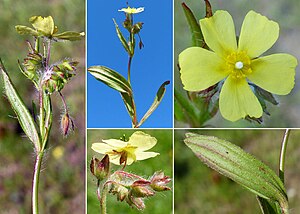Tuberaria lignosa
| Tuberaria lignosa | ||||||||||||
|---|---|---|---|---|---|---|---|---|---|---|---|---|

Tuberaria lignosa |
||||||||||||
| Systematics | ||||||||||||
|
||||||||||||
| Scientific name | ||||||||||||
| Tuberaria lignosa | ||||||||||||
| ( Sweet ) Samp. |
Tuberaria lignosa is a type of plant from the genus of the sand rose ( Tuberaria ) within the family of the rockrose family (Cistaceae).
description
Vegetative characteristics
Tuberaria lignosa is a perennial herbaceous plant that reaches heights of up to 40 centimeters. A woody "root stock" is formed as a permanent organ.
The leaves arranged in a basal rosette are "pseudo-stemmed". The simple leaf blade is 20 to 65 millimeters long and 8 to 25 millimeters wide and lanceolate to obovate. The upper side of the leaf is almost bare and the underside of the leaf is hairy tomentose to silky. The prominent three-veined leaf blade narrows at its base like a stalk. There are no stipules .
Generative characteristics
The flowering time is in spring and summer. The inflorescence shaft is 20 to 30 centimeters long and unbranched and has several pointed bracts . The terminal, zymous inflorescence contains only three to seven flowers.
The hermaphroditic flowers are radial symmetry and five-fold with a double flower envelope . Of the five sepals , the three inner ones are larger and the two outer ones smaller. They are egg-shaped and pointed with a length of 10 to 15 millimeters and a width of 4 to 7 millimeters. The corolla has a diameter of about 3 centimeters. The yellow, obovate petals are not spotted. There are many short stamens . The large scar is almost sessile.
Relatively small and three-lobed capsule fruits are formed.
The number of chromosomes is 2n = 14.
distribution
Tuberaria lignosa is common in the Mediterranean region in Morocco , Algeria , Tunisia , Portugal , Spain , Andorra , the Balearic Islands , France , Corsica , Sardinia , Italy , Sicily , Crete , Croatia , Serbia and Israel . An original occurrence in the Canary Islands is doubtful.
Taxonomy
It was first published in 1753 under the name Cistus tuberaria by Carl von Linné in Species Plantarum , page 526. In the genus Tuberaria (Dunal) Spach , however, the specific epithet tuberaria could not be used because otherwise a tautonym would have been created. So the next oldest species name had to be used, namely the name Helianthemum lignosum Sweet , which was published in Cistineae , Plate 46, 1830. The new combination to Tuberaria lignosa was made in 1922 by Gonçalo Sampaio in Bol. Soc. Loaf. , Series 2, 1, page 128. Synonyms for Tuberaria lignosa (Sweet) Samp. are: Xolantha tuberaria (L.) Gallego, Muñoz Garm. & C. Navarro , Diatelia tuberaria (L.) Demoly , Helianthemum lignosum Sweet , Helianthemum tuberaria (L.) Mill. , Tuberaria melastomatifolia (Spach) Grosser , Tuberaria vulgaris Willk. nom. illegal.
Individual evidence
- ↑ a b c d e f g Michael Charles Faraday Proctor: Tuberaria (Dunal) Spach. , P. 285 f. In: Thomas Gaskell Tutin et al .: Flora Europaea . Volume 2: Rosaceae to Umbelliferae. , Cambridge University Press 1968, ISBN 0-521-06662-X . ( limited preview in Google Book search)
- ^ Tuberaria lignosa at Tropicos.org. In: IPCN Chromosome Reports . Missouri Botanical Garden, St. Louis
- ↑ a b c d Eckhard von Raab-Straube (2018): Cistaceae. : Datasheet Tuberaria lignosa In: Euro + Med Plantbase - the information resource for Euro-Mediterranean plant diversity.
- ^ Tuberaria lignosa at Tropicos.org. Missouri Botanical Garden, St. Louis, accessed August 17, 2020.
Web links
- Tuberaria lignosa on botany.cz.